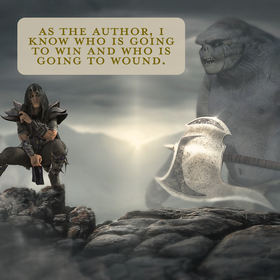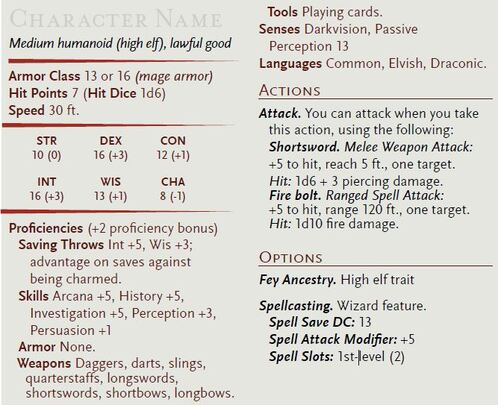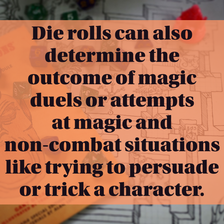|
From swashbuckling sword-and-sorcery to motorcycle chases through cyberpunk neon streets, well-written action scenes are an integral part of many sci-fi and fantasy stories. Good combat sequences and action scenes happen fluidly and are part of the story's flow. Satisfying action scenes are simple to read but not so easy to write. In this series, I'm investigating what goes into a successful action sequence. I'm a lifelong Dungeons and Dragons player, and I use many D&D techniques when writing (see my entire series on using alignment to write characters). Even if you're not a D&D player, you can still use a 20-sided die (D20) to aid in writing combat scenes. Using die rolls adds an element of chance to action sequences, making them easier to write and more realistic. Character StatisticsIf you're familiar with D&D, you might want to just write up a whole character sheet for each of your main characters and, maybe, a less detailed one for any other characters involved in combat. Character sheets are a great way to create a "sketch" of your characters, even if you're not going to use them for battle. You can find a collection of blank and prefilled character sheets here: https://dnd.wizards.com/charactersheets As you can see from the sheet, you give numbers to your character's attributes. A lot of these, such as charisma and wisdom, are primarily for character development. But, many of them are useful for combat and action scenes. Attribute ranking for most characters will range between one and five. Five, however, should be used only if the character is very proficient or even a master in the category. A negative score indicates an area of weakness. Character statistics are added (or subtracted) from die rolls, then it's up to me to decide what those die rolls mean. Rolling Combat As the author, I know how I want the scene to turn out. I know who is going to win and who is going to wound. Rolling for combat adds an element of guided chaos to my action scenes. Here's an example of how I might use the D&D technique to create an action scene: I have two characters: Robin the fairy and a troll name Rax. Robin is small, so she has stats that give her a roll modifier of -1 in strength, a +3 in dexterity, and she has 8 hit points (hit points are the number of points of damage she can take before she goes unconscious or dies). Rex has +2 strength, -1 dexterity, and 12 hit points. Robin has a dagger that does 1d3 (one three-sided die roll) of damage, and Rex has a sword that does 1d6 of damage. For simplicity, let's say that both characters are not wearing armor, which makes their armor class 10 plus their dexterity modifier. So, Robin has an effective armor of 13, and Rex has 9. These are the numbers the other character must overcome to make physical contact.
Already we see that the size and skills of the two fantasy characters are represented with the numbers. There's a whole system for deciding who goes first in combat, but we're going to skip that today too. We'll assume that Robin goes first because her high dexterity means she's generally faster. Here are the rolls and how I interpret them for combat: Round 1: Robin Rolls 19(-1) total: 18 Rex's Armor: 9 I think: This is more than enough to make contact and is a lucky strike for Robin. I roll a d3 and determine that she makes 3 points of damage. If I want, I can even use a body die to roll where Robin hit Rex. What I write: Rex watches for a moment as the little fairy comes barreling down the trail, her wings furiously beating as they carried her along at top speed. Is she really going to try to attack me? Rex lazily looks down at his scabbard, wondering if it was worth it to draw the sword or if he could just swat her away. In the millisecond he wasn't looking, Robin flew to his side and jabbed her deadly sharp dagger into his ear. "Bugger," Rex yelled as he unsheathed his sword and clasped his hand to his bloody ear. Round 2: Rex Rolls: 7 (+2) total: 9 Robin's Armor: 9 I think: Rex's hit doesn't overcome her armor class, but it almost does. It's not a great roll, and I need to reflect that in the story. What I write: Still grasping his ear with one hand, Rex swings wildly with his sword. His sword is so big, and Robin is so tiny, he almost crushed her with the broadside. Robin flitted away, searching for her another chance for a swift attack. … and do on… I might also watch the number of hit points left to determine when a character is wounded or killed, or I might use my own judgment. Usually, it's a mix of both. Quick Roll I don't have to write out a whole character sheet to determine the outcome of a combat situation or action scene. For quick encounters, side characters, and short stories, I might just quickly roll a 20 sided (or any-sided) die to see who wins an encounter and by how much. In these cases, it's more of a writing prompt or a way to keep the words flowing without having to stop typing for long. If I already have a character sheet made, that makes die rolls even quicker and backloads with more information. Die rolls can also determine the outcome or act as prompts for magic duels or attempts at magic and non-combat situations like trying to persuade or trick a character. Other blogs in this series:
0 Comments
Leave a Reply. |
Alison Lyke
Categories
All
Archives
November 2022
|




 RSS Feed
RSS Feed
